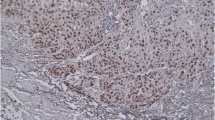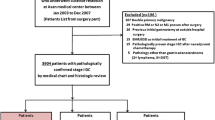Abstract
The aims of this study are to analyze the failure patterns in radical resected gastric adenocarcinoma, and to evaluate the correlation between recurrence patterns and potentially prognostic factors, including clinical pathological characteristic and biomarkers. Between Jan 2004 and Jun 2006, 84 patients were enrolled into the database analysis, including 8 with clinical stage I, 20 with clinical stage II, 21 with clinical stage IIIA, 22 with clinical stage IIIB and 13 with clinical stage IV, male 61 and female 23. The collected biomarkers including: preoperative tumor markers: CEA, AFP, CA199, CA50, CA72-4 and CA24-2; postoperative immunohistochemical (IHC) markers: Bax, Bcl-2, P27, CyclinD1, TOPO2, MDR, GST-π, Ki67, epidermal growth factor receptor (EGFR), P21, P53, proliferating cell nuclear antigen (PCNA), C-myc and Neu. Three-year local control rate (LCR), disease-free survival (DFS) and over-all survival (OS) were 66, 61 and 64% respectively. Logistic regression analysis showed cyclinD1 and CEA were correlated with prognosis; cyclinD1, CEA were correlated with loco-regional recurrence; PCNA was correlated with remote metastasis; bcl-2, ki67, c-myc2 and Neu were correlated with lymph node metastasis. The present study indicate that patterns of recurrence are variable and may be associated with specific biomarkers, in addition, high level of CEA and low-expressed of cyclinD1 resulted in poor prognosis.



Similar content being viewed by others
References
Parkin DM, Bray F, Ferlay J, Pisani P (2005) Global cancer statistics 2002. CA Cancer J Clin 55:74–108
Theuer CP, Kurosaki T, Ziogas A, Butler J, Anton-Culver H (2000) Asian patients with gastric carcinoma in the United States exhibit unique clinical features and superior overall and cancer specific survival rates. Cancer 89:1883–1892
Noguchi Y, Yoshikawa T, Tsuburaya A, Motohashi H, Karpeh MS, Brennan MF (2000) Is gastric carcinoma different between Japan and the United States? Cancer 89:2237–2246
Macdonald JS, Smalley SR, Benedetti J, Hundahl SA, Estes NC, Stemmermann GN, Haller DG, Ajani JA, Gunderson LL, Jessup JM, Martenson JA (2001) Chemoradiotherapy after surgery compared with surgery alone for adenocarcinoma of the stomach or gastroesophageal junction. N Engl J Med 345:725–730
Roukos DH, Kappas A (2005) Perspectives in the treatment of gastric cancer. Nat Clin Pract Oncol 2:98–107
Roukos DH, Murray S, Briasoulis E (2007) Molecular genetic tools shape a roadmap towards a more accurate prognostic prediction and personalized management of cancer. Cancer Biol Ther 6:308–312
Roukos DH (2008) Innovative genomic-based model for personalized treatment of gastric cancer: integrating current standards and new technologies. Expert Rev Mol Diagn 8:29–39
Roukos DH (2002) HER2 and response to paclitaxel in node-positive breast cancer. N Engl J Med 358:197 (author reply 8)
Schwarz RE, Zagala-Nevarez K (2002) Recurrence patterns after radical gastrectomy for gastric cancer: prognostic factors and implications for postoperative adjuvant therapy. Ann Surg Oncol 9:394–400
Landry J, Tepper JE, Wood WC, Moulton EO, Koerner F, Sullinger J (1990) Patterns of failure following curative resection of gastric carcinoma. Int J Radiat Oncol Biol Phys 19:1357–1362
Yoo CH, Noh SH, Shin DW, Choi SH, Min JS (2000) Recurrence following curative resection for gastric carcinoma. Br J Surg 87:236–242
D’Angelica M, Gonen M, Brennan MF, Turnbull AD, Bains M, Karpeh MS (2004) Patterns of initial recurrence in completely resected gastric adenocarcinoma. Ann Surg 240:808–816
Shin EY, Lee BH, Yang JH (2000) Up-regulation and co-expression of fibroblast growth factor receptors in human gastric cancer. J Cancer Res Clin Oncol 126:519–528
Aoyagi K, Kohfuji K, Yano S (2001) Evaluation of the epidermal growth factor receptor (EGFR) and c-erbB-2 in superspreading-type and penetrating-type gastric carcinoma. Kurume Med J 48:197–200
Garcia I, Vizoso F, Andicoechea A (2001) Clinical significance of epidermal growth factor receptor content in gastric cancer. Int J Biol Markers 16:183–188
Kofuji K, Hashimoto K, Kodama I, Aoyagi K, Ota J, Takeda J, Kakegawa T (1993) Expression of the growth factors (EGF, EGFR, and TGF alpha) and PCNA in superspreading and penetrating types of gastric carcinomas. Nippon Geka Gakkai Zasshi 4:8–92
Lee EY, Cibull ML, Strodel WE, Haley JV (1994) Expression of HER-2/neu oncoprotein and epidermal growth factor receptor and prognosis in gastric carcinoma. Arch Pathol Lab Med 8:235–239
Qin H, Sun Y, Benveniste EN (1999) The transcription factors Sp1, Sp3, and AP-2 are required for constitutive matrix metalloproteinase-2 gene expression in astroglioma cells. J Biol Chem 74:29130–29137
Price SJ, Greaves DR, Watkins H (2001) Identification of novel, functional genetic variants in the human matrix metalloproteinase-2 gene: role of Sp1 in allele-specific transcriptional regulation. J Biol Chem 276:7549–7558
Monig SP, Baldus SE, Hennecken JK, Spiecker DB, Grass G, Schneider PM, Thiele J, Dienes HP, Holscher AH (2001) Expression of MMP-2 is associated with progression and lymph node metastasis of gastric carcinoma. Histopathology 39:597–602
Yao JC, Wang L, Wei D, Gong W, Hassan M, Wu TT, Mansfield P, Ajani J, Xie K (2004) Association between expression of transcription factor Sp1 and increased vascular endothelial growth factor expression, advanced stage, and poor survival in patients with resected gastric cancer. Clin Cancer Res 10:4109–4117
Garcia I, Vizoso F, Martin A, Sanz L, Abdel-Lah O, Raigoso P, Garcia-Muniz JL (2003) Clinical significance of the epidermal growth factor receptor and HER2 receptor in resectable gastric cancer. Ann Surg Oncol 10:234–241
Goral V, Yesilbagdan H, Kaplan A, Sit D (2007) Evaluation of CA 72-4 as a new tumor marker in patients with gastric cancer. Hepatogastroenterology 54:1272–1275
Spila A, Roselli M, Cosimelli M, Ferroni P, Cavaliere F, Arcuri R, Tedesco M, Carlini S, D’Alessandro R, Perri P, Casciani CU, Greiner JW, Schlom J, Guadagni F (1996) Clinical utility of CA 72-4 serum marker in the staging and immediate post-surgical management of gastric cancer patients. Anticancer Res 16:2241–2247
Livingstone JI, Yasui W, Tahara E, Wastell C (1995) Are Japanese and European gastric cancer the same biological entity? An immunohistochemical study. Br J Cancer 72:976–980
Shen L, Liu Z, Tu Y, Xu L, Sun X, Wu S (2010) Regulation of MMP-2 expression and activity by β-1,3-N-acetylglucosaminyltransferase-8 in AGS gastric cancer cells. Mol Biol Rep 38(3):1541–1550
Luo XR, Li JS, Niu Y, Miao L (2010) Targeted killing effects of double CD and TK suicide genes controlled by survivin promoter on gastric cancer cell. Mol Biol Rep 38(2):1201–1207
Xu CX, Yan YF, Yang YP, Liu B, Xin JX, Chen SM, Wang W, Jiang CY, Lu ZX, Liu XX (2010) Downregulation of ornithine decarboxylase by pcDNA-ODCr inhibits gastric cancer cell growth in vitro. Mol Biol Rep 38(2):949–955
Zhang L, Huang H, Wu K, Wang M, Wu B (2010) Impact of BTG2 expression on proliferation and invasion of gastric cancer cells in vitro. Mol Biol Rep 37(6):2579–2586
Author information
Authors and Affiliations
Corresponding author
Additional information
We declare that out study has not been supported by any Commercial Sponsorship.
Electronic supplementary material
Below is the link to the electronic supplementary material.
Rights and permissions
About this article
Cite this article
Li, GC., Zhang, Z., Ma, XJ. et al. Are biomarkers correlated with recurrence patterns in patients with resectable gastric adenocarcinoma. Mol Biol Rep 39, 399–405 (2012). https://doi.org/10.1007/s11033-011-0751-0
Received:
Accepted:
Published:
Issue Date:
DOI: https://doi.org/10.1007/s11033-011-0751-0




